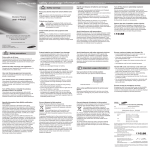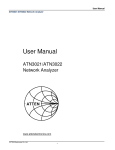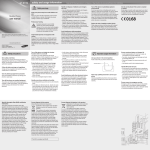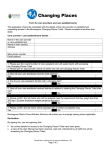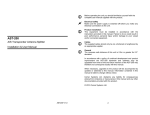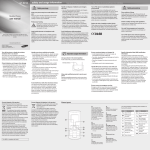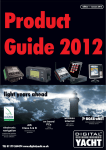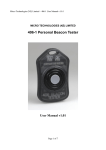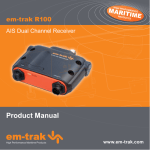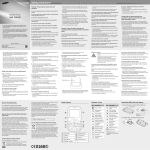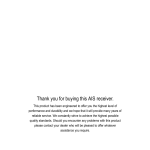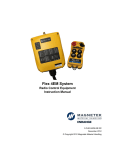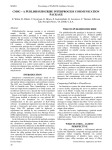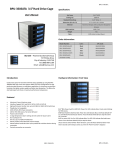Download SPL250 User Manual
Transcript
SPL250 User & Installation Handbook DIGITAL YACHT SPL250 AIS Transponder Antenna Splitter Installation & User Manual SPL250-1 IMPORTANT INFORMATION L Before operating the unit you should familiarise yourself with the complete user manual supplied with the product. a Electrical safety Make sure the power supply is switched off before you make any electrical connections to the unit. L Product installation This equipment must be installed in accordance with the instructions provided in this manual. Failure to do so could result in poor performance, personal injury and/or damage to your vessel and/or connected equipment. L Cables The supplied cables should not be cut, shortened or lengthened as this will reduce the performance of the product. If longer cables are required you should obtain a replacement cable from an appropriate supplier. L General The compass safe distance of this unit is 0.5m or greater for 0.3° deviation. In accordance with a policy of continual development and product improvement the Digital Yacht SPL250 hardware and software may be upgraded from time to time and future versions of the Digital Yacht SPL250 may therefore not correspond exactly with this manual. When necessary upgrades to the product will be accompanied by updates or addenda to this manual. Information contained in this manual is liable to change without notice. Digital Yacht Ltd. disclaims any liability for consequences arising from omissions or inaccuracies in this manual and any other documentation provided with this product. © 2008 Digital Yacht Ltd. Any questions please call: 01179 114111 INTL + 44 1179 114111 2 1. Introduction Congratulations on the purchase of your AIS Transponder Antenna Splitter. It is recommended that your antenna splitter is installed by a professional installer. The Digital Yacht SPL250 allows your existing VHF antenna to be used by both a VHF radiotelephone and an AIS Transponder. The Digital Yacht SPL250 also includes an antenna connection for FM broadcast receivers providing a third use for your existing VHF antenna. This manual describes the installation and operation of the SPL250. 2. Installation 2.1 Before you start The following items are supplied in the SPL250 packaging: You will need the following items and tools to complete the installation: • Class B AIS Transponder. • Pre-installed VHF Antenna and cable. • Access to 12V DC or 24V DC power supply where the unit is to be installed, via a 1A rated fuse or circuit breaker. • Connector block or junction box for power connections. • Four M4 (no. 6) screws or other fixings appropriate to the mounting location. 2.2 Installing the unit Before starting installation select a suitable location for the antenna splitter. The unit is intended for installation below deck in a dry location. When locating the unit you should consider: 3 • • • • Routing of power and antenna cables to the unit. Provision of sufficient space behind the unit for cable connections. Maintaining the compass safe distance of 0.5m. Visibility of the front panel indicators. Installation Diagram Installation step 1 • Secure the antenna splitter to a flat surface in the selected location. Use four 5mm wood screws or other fixings suited to the material the unit is being fixed to. • The unit may be installed in any orientation. • Fixing point dimensions are shown below. 4 Installation step 2 Make the electrical connections to the antenna splitter as follows: • Connect the VHF antenna to the connector labelled ‘Antenna’. • Connect the antenna output of your VHF Radiotelephone to the connector labelled ‘VHF’. • Connect the antenna output of your AIS Transponder to the connector labelled ‘AIS’. • Optionally connect the antenna input of a FM Broadcast receiver to the connector labelled ‘FM’. • Connect 12VDC or 24VDC power supply to the power cable. o The red wire should be connected to the positive power supply connection via a 1A rated fuse or circuit breaker. o The black wire should be connected to the negative power supply connection. Installation step 3 Apply power and verify the unit is operating: • Apply power to the antenna splitter, AIS Transponder and VHF radio telephone. • Verify that the green power LED on the antenna splitter is illuminated. • Transmit using the VHF radio telephone and verify that the yellow LED on the antenna splitter marked ‘VHF’ is illuminated during the transmission. • Wait for the AIS Transponder to transmit its first position report. This is indicated by the green power LED on the AIS Transponder illuminating. During AIS Transponder transmissions the yellow ‘AIS’ LED on the antenna splitter will flash briefly. Class B AIS transmissions occur once every 3 minutes if your vessel is stationary. 3. Operation FM AIS ANT. Operation of the antenna splitter is automatic and requires no user intervention. • During operation the antenna splitter will share signals received at your VHF antenna with both the VHF Radiotelephone and the AIS Transponder. • When either connected device transmits, the antenna splitter will automatically route the transmission to the antenna. • VHF Radiotelephone transmissions (including DSC transmissions) are given priority over AIS transmissions. 5 L It is not possible for both connected devices to transmit simultaneously using a single VHF antenna. Whilst you are talking on your VHF Radiotelephone no AIS position reports will be transmitted. 4. Troubleshooting Problem Power LED not illuminated Solutions • • • Check power supply connections and fuse or circuit breaker. Check polarity of power supply connections. Check power supply voltage. ‘VHF’ LED does not illuminate when VHF Radiotelephone is transmitting. Check the antenna output of the VHF radiotelephone is connected to the antenna splitter input labelled ‘VHF’. ‘AIS’ LED does not illuminate when AIS Transponder is transmitting. Check the antenna output of the AIS transponder is connected to the antenna splitter input labelled ‘AIS’. Clicks or pops are heard from a connected FM broadcast receiver. This is normal and may occur during VHF or AIS transmission. VHF or AIS reception range is reduced. A slight reduction in receiver range is normal and due to the insertion loss of the antenna splitter. 5. Specification General Size (H x W x D) Mounting area (H x W) Weight Power Operating current (receive) Operating current (VHF transmit) Operating current (AIS transmit) Environmental Operating temperature Operating humidity Storage temperature RF performance VHF & AIS Frequency range Insertion loss, AIS Receive path Insertion loss, VHF Receive path Insertion loss, AIS Transmit path Insertion loss, VHF Transmit path Max input power, AIS port Max input power, VHF port Min input power, VHF port AIS port impedance VHF port impedance Antenna port impedance FM port impedance Switching time, Receive to AIS Transmit Switching time, Receive to VHF Transmit Connectors Power Antenna VHF Radiotelephone AIS Transponder FM broadcast receiver 120 x 120 x 60mm 145 x 120mm 260g 12VDC or 24DC supply 120mA typical at 12VDC -15°C to +55°C Up to 93% -20°C to +70°C 156.025MHz to 162.025MHz < 4dB < 4dB < 1dB < 1dB 12.5W 25W 100mW 50 Ω 50 Ω 50 Ω 75 Ω <10uS <10uS Flying lead SO-239 (UHF) connector SO-239 (UHF) connector BNC BNC 6 6. Declaration of conformity DECLARATION OF CONFORMITY with the R&TTE Directive 1999/5/EC We Digital Yacht Ltd of Marine House City Business Park, Easton Rd, Bristol. BS5 0SP declare under our sole responsibility that the product Digital Yacht SPL250, being an AIS Transponder Antenna Splitter, to which this declaration relates, is in conformity with the relevant sections of the following standards and/or other normative documents. For Article 3.1(a) [Health & Safety]: Health: EN 50384: 2002 for occupational exposure to electromagnetic fields EN 50385: 2002 for general public exposure to electromagnetic fields EN 50383: 2002 which is referenced by EN 50384: 2002 and EN 50385: 2002 Safety: EN 60950-1: 2001, Clauses 1.5 – 1.8, 2.2, 2.5, 2.9, 3, 3.5, 4, 4.5 – 4.7 & 5 IEC 60945: 2002-08, Clauses 7, 8.2, 8.3, 8.7, 8.8, 8.12 & 11.2 For Article 3.1(b) [EMC]: EN 301 843-1 v1.2.1 (2004-06) IEC 60945: 2002-08, Clauses 9.2, 9.3, 10.3, 10.4, 10.5 & 10.9 For Article 3.2 [Spectrum usage]: IEC 62287-1: 2006-03 Clause 11, for the AIS transmitter and receivers IEC 62287-1: 2006-03 Annex C, Clause C4, for the DSC receiver IEC 61108-1: 2003-07 Clauses 4.3.7 & 4.3.8, for the GPS receiver For Article 3.3(e) [Access to emergency services]: IEC 62287-1: 2006-03 Clause 9, for operation in intended environment IEC 62287-1: 2006-03 Clauses 10, 12,13 for operational requirements We hereby declare that all essential radio test suites have been carried out and that the above named product is in conformity to all the essential requirements of Directive 1999/5/EC.The conformity assessment procedure referred to in Article 10 and detailed in Annex [III] and [IV] of Directive 1999/5/EC has been followed with the involvement of the following Notified Body: BABT, Balfour House, Churchfield Road, Walton-on-Thames, Surrey, KT12 2TD, UK. Identification mark: 0168 The technical documentation relevant to the above equipment will be held at SRT Marine Technology Ltd., Wireless House, Westfield Industrial Estate, Midsomer Norton, Bath, BA3 4BS UK. The product is intended for sale in the following member states: Nicholas Heyes. Product Manager. Date: 28th July 2008 7







